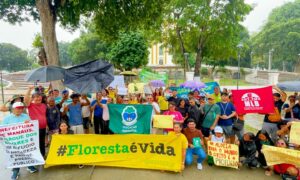Biocultural memory and the sustainable use of natural resources by traditional populations in the Mid-Juruá have the potential to regulate territorial protection and species conservation.
By Thais Alves
In the Mid-Juruá region (Carauari/AM), traditional populations, guardians of biocultural memory, emerge as the main responsible for territorial protection and conservation of natural resources. This is what the study carried out by researchers from the Federal University of Amazonas in partnership with local leaders entitled “Traditional knowledge associated with socio-biodiversity products: a look in defense of the holders of knowledge in the Middle Juruá territory, Amazonas, Brazil” and published this year in the journal Research, Society and Development.
“The traditional use of socio-biodiversity species is a strategic factor for their conservation, as this relationship between man and natural resource, in this context, enables the propagation of the species and maintenance of its ecosystems in the territory of the Middle Juruá”, is what the authors reflect.
In this sense, traditional use has the potential to regulate the protection of species by human societies. Seven main categories of species use were identified in the study, namely: cosmetic, food, medicinal, domestic, industrial, and fertilizer. In addition, traditional knowledge is passed on more consistently with closer coexistence, given the similarity between uses within the community.
The study also reveals how the construction and consolidation of traditional knowledge occurs in the territories, where the maintenance of this knowledge goes through several stages, exemplified in the figure below.
The path towards consolidation of traditional knowledge and its maintenance in the Mid-Juruá territory starts with the processes of occupation, migration, and human settlements that underpin the process. The integration of knowledge between different peoples such as indigenous and northeastern Brazilians, as well as the creation of locally based organizations provide necessary support for maintaining knowledge and branching out through articulation with different organizations, spheres, and instances. The results are evident in the diversity of production chains that drive the local economy and generate income, while a new governance model is built, combined with the improvement of processes that guarantee local strengthening, territorial protection, conservation of natural resources, and sustainable development.
The authors also draw attention to commercialization activities with a strictly economic purpose of some species that have potential to reduce traditional uses in communities and emphasize the fundamental role that populations play in the Mid-Juruá territory as knowledge holders and guardians of socio biodiversity.
Several organizations collaborated to carry out the research in the territory including local and partners such as the Association of Rural Producers of Carauari (ASPROC), Association of Agroextractivist Residents of São Raimundo (AMECSARA), Association of Agroextractive Women of Mid-Juruá (ASMAMJ), Association of of Agroextractivist Residents of Lower Mid-Juruá (AMAB), RDS Uacari Residents Association (AMARU), Mixed Cooperative for Sustainable Development and Solidarity Economy of Mid-Juruá (CODAEMJ), Campina Rural Family House, Chico Mendes Institute for Biodiversity Conservation ( ICMBio), Secretary of State for the Environment (SEMA). The research was funded by the State of Amazonas Research Support Foundation (FAPEAM) and carried out by the Federal University of Amazonas (UFAM).






